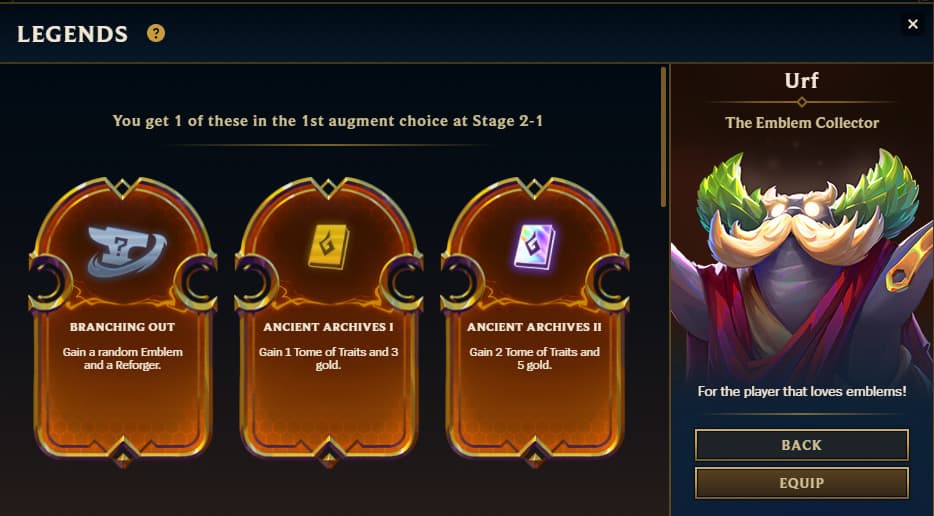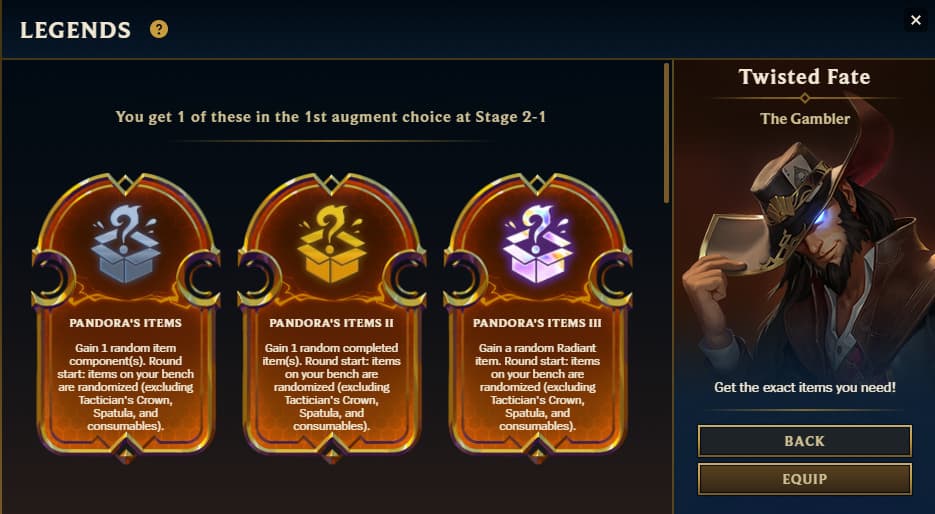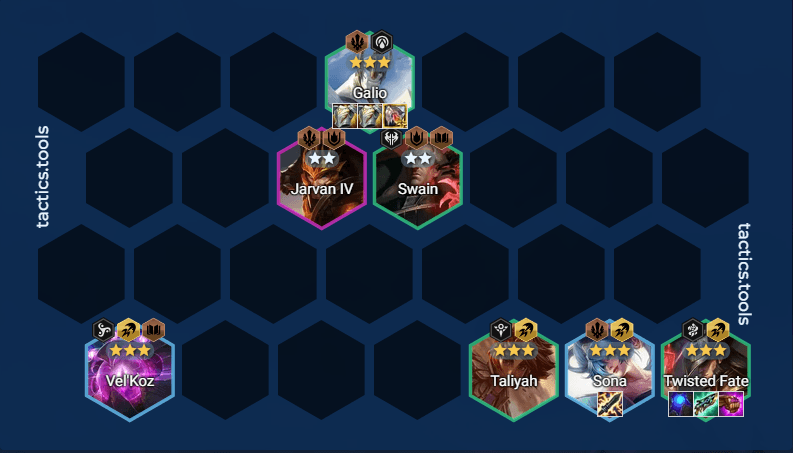These are currently the two strongest legends that you should be looking to play in the game.
After the deployment of patch 13.20b, one Teamfight Tactics (TFT) legend stood out in popularity in North America. Potentially a remnant from prior to the B-patch, the increasingly popular Twisted Fate was perhaps the most commonly picked legend.
However, across the Atlantic in China, a new legend strategy that rivaled the strength of him had already begun popping up. Its power was first put on full display in North America (NA) at the NA Last Chance Qualifier by winner DavidAs. Since then, it has been picking up in popularity both in tournaments and on the NA ranked ladder.
This legend that has boomed in popularity is Urf. Urf's 2-1 augment gives you a guaranteed +1 of any trait. If your game offers you a prismatic 2-1 augment choice, then you potentially have a +2 of any trait. While Urf has seen a surge in play rate and success, the Twisted Fate legend remains a mainstay in NA ranked play. Here is how to succeed playing these two legends.
A TFT best legend: Urf

Like other legends, Urf has very clear advantages and disadvantages. Urf's two biggest advantages are the early direction it provides the player and the ability to cap out on a vertical synergy. Vertical synergy means investing more deeply into units of the same trait. Examples include 7 Demacia or 7 Noxus. Whatever emblem you receive or choose determines what composition you will be looking to play, with the goal of ending in a vertical synergy.
Urf is a bit of a double-edged sword. The early direction it provides may force you into a line that you are not comfortable with or isn't quite as strong in the meta. It also widens the possibility of the strongest board you should be playing throughout the game. While where you want to end up may be relatively clear, your road there might have some twists and turns, forcing you to adapt on the fly.
Your 3-2 and 4-2 Urf augment option when playing this legend are fallback options that often will want to be selected as a last resort. The Urf strategy is strong mainly due its 2-1 offering, granting the Tome of Traits.
Tailoring Tome of Traits
The main goal of this Urf guide is for you to understand its popularity and the risks and rewards of selecting it. It is also to teach how to minimize that risk and increase your chances of success. To do that, you will need to understand tailoring.
Knowing this trait tailoring table is essential for maximizing your chances of getting an emblem you want. An active trait means that you are fielding at least two or three units from the same trait. And by doing so, you are activating its trait bonus such as 3 Noxus, 3 Demacia, 2 Sorcerer, etc. An inactive trait means you are fielding at least one unit from a certain trait, but not enough to activate its trait bonus.
Number of Traits | Tailored Emblems |
|---|---|
| 6-7 | One |
| 8-9 | Two |
| 10-11 | Three |
| 12+ | All Four |
When you use your Tome of Traits, it will be tailored according to the board you played in the previous fight. What this means is the more active and inactive traits were featured on your board during the finished combat before using the tome, the more likely you will receive one from those traits. If you played 6-7 traits, then one emblem will be of the traits in the list, and the other three random. As shown on the table, the amount of tailored emblems increases in correlation to the number of traits.
So on Stage 1-4, do your best to play units that allow you to reach 8 traits, active or inactive. Make sure these traits include the compositions you are most comfortable with. Consequently, on Stage 2-1, you can use your Tome of Traits to provide you with the early game direction you need.
What's the best emblem?
Strong and popular TFT emblems include Bastion, Bruiser, Demacia, Noxus, Shurima, and Slayer. Demacia, Noxus, Shurima, and Slayer are some of the strongest emblems, allowing you to cap your board in the late game with the 6 or 7 active version of the trait bonus. Rogue, Gunner, and Bilgewater emblems are less standout emblems that can also be potentially utilized to succeed.
If you are using this strategy to climb, the gold and prismatic augments should often be selected. The silver augment can be a much higher risk as there is no option to tailor. However, if you are comfortable playing any composition, it could still be in your best interest to choose it. Playing a TFT best legend like Urf over a large number of games means you'll have to be comfortable on a lot of lines, but the rewards can be well worth the trouble.
A TFT best legend: Twisted Fate

The Twisted Fate legend has been one of best TFT legends for a few patches now. While Urf has become increasingly popular, Twisted Fate still has its place. When picking this legend, you will almost always choose this augment and force a certain direction by saving your item bench for the best items possible on your carry. The pros and cons to this strategy are clear.
By continuously saving your items on your bench so that they roll into "perfect" item combinations, your board will generally be weaker than others if they are not doing the same. You will lose tempo and HP early to trade for a larger spike in strength later in the game. However, this means you should never be unhappy with the items that you do end up with.
Additionally, if you are forcing a certain composition, you will likely always be looking for the same units every game and will not get lost on that front. The difficulty will be playing the strongest board with units that hold any items you are able to make and adapting your decision-making based on how well people are doing if they are contesting your composition.
What to play with the Twisted Fate legend

This is your standard Twisted Fate carry composition that you should want to default to playing when selecting the Twisted Fate legend. If contested, you may not be able to 3-star everything. This might mean you will have to pivot to Jarvan as a tank or Vel'koz as a carry. But this composition can support more than one player, so sticking to reroll Twisted Fate could be your best bet.
Another successful composition featuring Vel'koz that may start to see more popularity is the one mentioned above.
Lastly, you can also use the Twisted Fate Pandora's Items to play Rapid Fire Cannon-stacking Nilah and Mordekaiser carry compositions as a last resort. A combination of Rapid Fire Cannon and Giant Slayer on Nilah enables her as a carry. However, this strategy sacrifices a lot of HP and tempo, to the point where you may find yourself eliminated or too unhealthy to recover by the time you stabilize.
That's all for now. Stay tuned to esports.gg for the latest TFT news and updates.